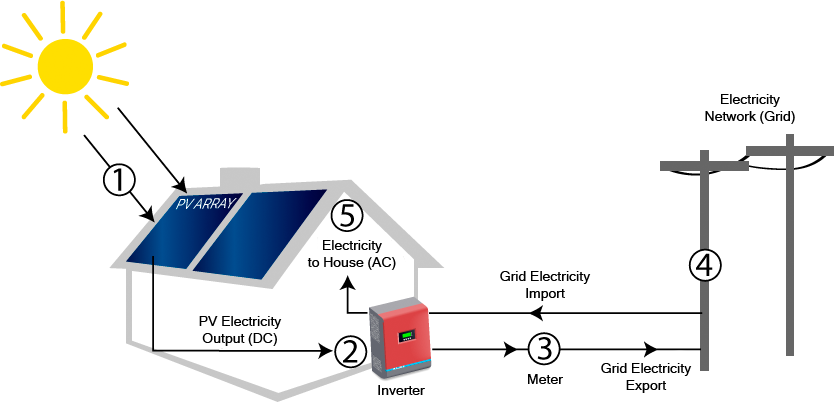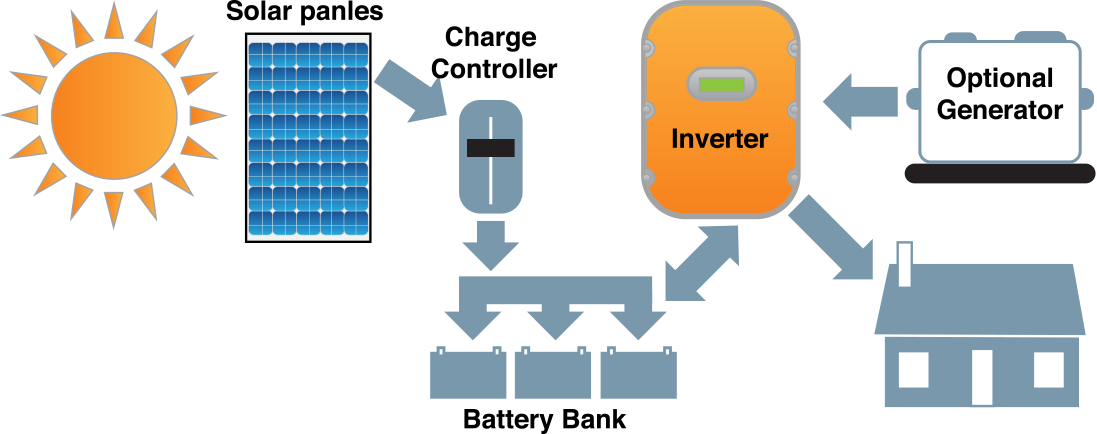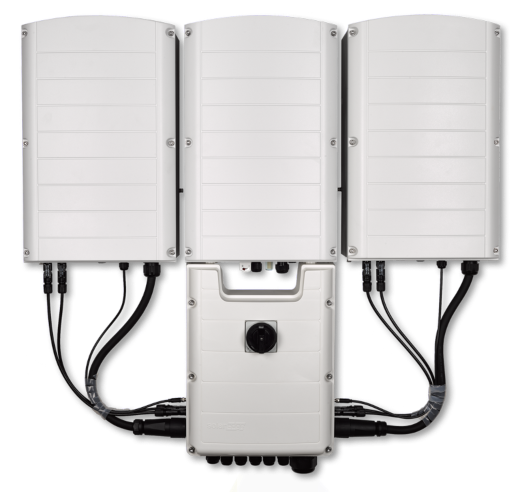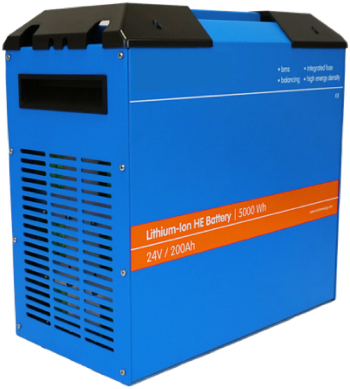Solar Systems Explained
- Home
- Solar Systems Explained
We design and install the following solar systems:
1. On-Grid Solar System
2. Off-Grid Solar System
3. Hybrid Solar System
4. Portable Power System
5. Solar Panels (PV’s)
6. Inverters
7. Storage (Batteries)
On-Grid Solar System
On-Grid Solar System
it is commonly known as:
– grid-connect solar
– grid-tie solar
– grid-feed solar
This is a solar power system that is connected to the Municipality grid. It has no batteries connected to it thus reduces the costs of the system. The solar panels generate direct current (DC) electricity when light hits them and that gets converted to AC by the inverter and to the connected loads, the grid takes over should there not be enough power produced by the solar panels

Off-Grid Solar System
An off grid solar system uses the basic principles of solar power. When we say this, we simply mean that with this system there are panels that are used to collect the sun’s energy. Once the initial energy is collected it is then sent to a solar inverter which then sends the power to a battery inverter.
From there it will use energy to power electronics that are in your home. In the end, whatever green energy is created and is not used goes to the battery bank. This is a personal battery that saves power for the home to use at night or on days that are cloudy and overcast.

On-Grid and Off-Grid Solar System Difference
The main difference between an on grid and an off grid solar system design is just how it sounds like in the name. The off grid systems rely on a battery to save all the power created just for that one household or building. An on grid solar system is the opposite.
Any power that is created by that home or buildings solar panels is sent to an electricity grid where anyone who is also connected to that same grid can use that energy. This can be a good thing to have in cases where there is no solar energy being created for long periods of time.

Hybrid Solar Power Systems
Hybrid solar power systems are the best of both worlds: you get the guaranteed (well, 99.9% of the time) electricity supply of the grid, with the ability to store your excess solar energy for use when the sun isn’t shining. This typically reduces your dependence on grid imports by 70% to 95%
Hybrid systems are also at least half the price of an off-grid system. They’re still more expensive than a purely on-grid system, though – typically double the price of grid-connect solar. A hybrid system is generally configured to charge the batteries with excess solar energy – as this is the cheapest form of energy you can get. Once the batteries are full, the excess solar can be sold back to the grid- (Once South African legislation allows users to do so).
When there is not enough solar energy to power your home or commercial property, the battery inverter will do its best to provide power from the battery. If it can’t provide enough power because it is running flat, then the grid will provide the shortfall.
Portable Solar System
Portable Power Supply series offers highly versatile
and portable power supply solutions, powering your
equipment or devices whether working from home, office,
during loadshedding or no power connection at all. It is a
convenient and easy to use device.
It can also be a critical power source in an event of an
emergency and is a reliable portable supply for your home,
office and emergency needs.


Solar Panels-PVs
We supply the following high quality solar products:
Solar Photovoltaic ( Solar Panels-PVs)
We supply 2 types of solar panels that are:
1. Monocrystalline
2. Polycrystalline
Monocrystalline panels consist of singular large crystals, are darker in colour, even in aesthetic consistency and, as a result of the production process, the corners of cells are usually missing.
Polycrystalline panels consist of multiple smaller crystals, can be light or dark blue in colour and have variation in texture where some patches are lighter than others.
Inverters
Micro-inverters
Compared to standard string inverters, micro-inverters are much smaller in both physical size and capacity, ranging from just 200 to 250W. Unlike a standard inverter that converts all the DC electricity your panels collectively produce, a single micro-inverter is installed on the back of every individual panel in your system. Solar PV systems utilising micro-inverters usually perform better than standard string inverter systems. Micro-inverters also allow you to monitor the performance of individual solar panels. At double to three times the cost of standard string inverters, micro-inverters do not come cheap. As they only typically exceed a string inverters performance by 6 to 8%, often the cost savings do not make up for the initial increased outlay. Plus, because they sit on the roof with your panels, they are more vulnerable to extreme weather conditions.
Battery Inverters
Responsible for the charging and discharging of the solar electricity stored in a battery system, battery inverters are often installed alongside a standard string inverter. Battery inverters are often robust and hard-wearing.
Hybrid Inverters
Performing the same function as standard string inverters and battery inverters, hybrid inverters convert the DC electricity your panels generate into AC electricity your home can use, in addition to charging and discharging your solar battery bank.
Purchasing a hybrid inverter is a more affordable and easier solution than installing both a standard string and battery inverter. Plus, because the majority of hybrid inverters can be installed without a battery, purchasing a hybrid inverter gives you the flexibility to retrofit a solar battery at a later date. Because a hybrid inverter is tasked with undertaking two integral functions, they can be less efficient than separate standard string and battery inverters.
Off-Grid Inverters
Just like standard string inverters that are connected to the grid, off-grid inverters are responsible for the conversion of DC electricity into AC electricity.
Unlike standard string inverters however, they do not have the capacity to export excess solar electricity into the grid. This is why off-grid inverters are used in either remote areas, or where the home or business owner wants to separate from the grid completely.
By separating from the grid, an off-grid inverter system means your home or business is no longer susceptible to power outages caused by the grid, giving you greater energy independence. This inverter is ideal for South African environment.
Some off-grid inverters come with the bonus of a built-in AC charger option, giving you’re the ability to not only connect a backup generator, but also charge a battery storage system.

Storage (Batteries)
There are four main types of battery used in connection with storing electricity from solar power systems. Below is a summary of the various technologies currently commercially available:
Lead acid
Ugly and bulky definitely. But also reliable, tried and tested. But they are rapidly being eclipsed by other technologies with longer warranties and lower pricing as solar battery storage becomes more popular.
Lithium-ion
Lithium-ion (Li-ion) batteries are evolving in leaps and bounds as the electric car industry drives their development. Lithium-ion batteries are looking to become the most popular choice for on-grid solar battery storage for the foreseeable future.
Flow
Flow batteries are a relatively new entrant to the battery storage marketplace (though their technology has been around for many years). They are called flow batteries because they have a water based solution of zinc-bromide sloshing around inside them.
Sodium Nickel Chloride
Sodium nickel chloride technology is yet another competitor to the dominant lithium-ion storage technology.

